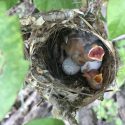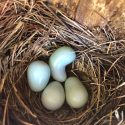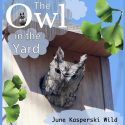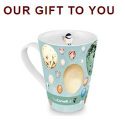 Photo ©
Keith Williams
Photo ©
Keith Williams

On Cowbirds and Changelings
How did the bizarre folklore of the “changeling” child first enter European literature? Perhaps an avian reproductive strategy called “brood parasitism” served as inspiration. Brood parasitism is how some birds avoid the work of raising young by laying eggs in the nests of other birds.
In our latest blog post, we explore the origins of the fairy changeling lore by examining some real-life changelings (i.e., cowbirds and cuckoos). Read on for a fanciful new take on folk stories as they relate to nesting biology.

NestWatcher Spots Odd Eggs
Christine Boran of Virginia shared this photo from a nest box on the Woolwine House Bluebird Trail. Something has caused three of the four Eastern Bluebird eggs to be malformed, the most extreme of which is bean-shaped. At the time of writing, 2 eggs had hatched, but only 1 nestling survives (now 10 days old on August 23rd, 2018).
In her 13 years of nest monitoring, Christine says she has never seen anything like this before. We sought the opinion of Dr. Mark Hauber, author of The Book of Eggs: A Life-Size Guide to the Eggs of Six Hundred of the World’s Bird Species, about what could have caused this. Dr. Hauber told us, “It looks like the female laid the eggs too fast without the shell being fully formed—I would suspect that these eggs are incredibly thin. They are incredible eggs indeed!” Bluebirds typically lay one egg per day, so in this case “too fast” is relative to the 24-hour laying interval.
Christine is closely watching this nest, and she invites interested NestWatchers to follow along on the trail’s Facebook page.

We Sparked a Kid’s Book
We were delighted to learn that the Right Bird, Right House tool on our website helped to inspire a new children’s book! June Kasperski Wild reached out to tell us that she and her family were researching nest boxes when they found our website. After downloading our free owl box plan, what followed was an adventure in learning about their backyard Eastern Screech-Owls’ nesting habits. Ms. Wild was inspired to write a long poem, which forms the foundation of the new book The Owl in the Yard.
A freelance writer, June credits NestWatch as the spark that set her creativity in motion:
“Many thanks to NestWatch for the inspiration. Researching and building the birdhouse and then viewing the owl family wouldn’t have been possible without your help! This was an amazing time for our family. One that we will never forget!”
We’re so happy that our free resources brought such joyful memories to the Wild family.

Get a Limited Edition Egg Mug
If you like eggs with your coffee, you’re going to love our new limited edition mug. This porcelain mug is adorned with the eggs of common North American birds, hand illustrated by Bartels Science Illustration Intern Virginia Greene. A sweet chickadee is perched inside—can you find which egg is hers?
While supplies last, we are sending this mug to NestWatch supporters who make a gift of $100 or more.* Your gifts help support our program, which continues to grow each year. In the past year, we have released a mobile app, created a new science curriculum for middle school students, and published three scientific studies. Your gifts enable NestWatch to keep thriving and reaching new audiences. Thank you for making a special gift this nesting season!
*Note: we are only able to ship to U.S. mailing addresses at this time. International residents, please email us at nestwatch@cornell.edu for details.